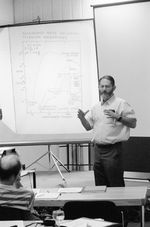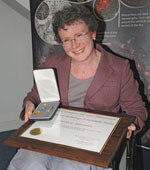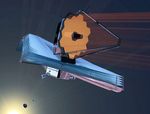NASA award for telescope innovation to Edinburgh Scientist
15th of July, 2010
The late Dr Timothy Hawarden, who was based for many years at the ’STFC's UK Astronomy Technology Centre (UK ATC), has been awarded a NASA Exceptional Technology Achievement Medal for his pioneering work on innovative cooling techniques that make possible future infrared space telescopes, including the one that will follow the Hubble Space Telescope. The awards were presented at NASA’s Goddard Space Flight Center, home of the Hubble, on 16 June 2010. Nobel laureate, Dr, John Mather, an American astronomer who was an early convert to Tim’s concept, accepted it on Tim’s behalf.
The medals accompanying the award were presented to Tim’s widow, Frances, today (15 July 2010) at a brief ceremony held at the UK ATC (formerly the Royal Observatory Edinburgh or ROE) during a meeting of the Science Working Group for the James Webb Space Telescope. At the ceremony Robert Smith, an historian charged with writing a comprehensive history of this huge NASA/ESA mission, gave an introduction to the significance of Tim’s work to an audience of NASA and ESA scientists together with some of Tim’s colleagues at the UK ATC.
Tim has been awarded a 2010 NASA Exceptional Technology Achievement Medal, the highest such award given by NASA, "For the breakthrough concepts that made possible the James Webb Space Telescope and its successors." Tim was informed last autumn that he had been nominated for this award and his many friends think that it is very sad that he did not live long enough to collect it in person.
Infrared telescopes in space, such as the Webb Telescope, must be very cold so that heat from the mirrors themselves will not overwhelm the faint light from distant astronomical sources. Tim’s breakthrough idea was to do away with the traditional method of cooling space telescopes using huge tanks of cryogenic coolants such as liquid helium, and instead to use a combination of sun shields and radiators to allow space telescopes to lose heat passively – allowing the heat to simply radiate away into cold space. The advantages of this are twofold: the lifetime of a telescope is not limited by the amount of coolant that can be launched, and the telescope, including, crucially, the main mirror, can be much bigger since it does not have to be encased in what amounts to a very large thermos flask. A larger main mirror makes it easier for the telescope to see fine detail and very faint objects.
The idea initially met with significant resistance from the space science community but gradually, and after many false starts, it began to be accepted. It was finally embraced by NASA and ESA in the designs for space telescopes such as Spitzer (launched August 2003 with a modified design including radiative cooling), Herschel (launched May 2009) and the James Webb Space Telescope which is due to be launched in 2014.
Professor, Malcolm Longair, who was Director of the ROE and Astronomer Royal for Scotland throughout the 1980s, witnessed Tim’s dedication to his new ideas first hand: "I can recall vividly Tim's excitement when he realised in the mid-1980s that passive cooling was the way to design infrared space telescopes. His prescient vision was studied in collaboration with technology experts at the ROE and ESA, and they showed unambiguously that a space telescope would cool spontaneously to those temperatures at which it would come into "thermal equilibrium" with the space environment. This deep insight was before its time, but it is now the preferred method for the construction of large cooled space telescopes such as the James Webb Space Telescope. Despite set-backs, Tim never gave up in enthusiastically promoting his concept which has proved to be so important for space astrophysics."
Professor Ian Robson, Director of the UK Astronomy Technology Centre, said: ”This is an excellent example of a scientist, who originally was not working in this field at all, but who studied the problem and produced an innovative, left-field solution; brilliantly simple in principle and highly cost – effective in practice. Indeed, Tim was working for me in Hawaii at the time as a Telescope Support Scientist for the UKIRT telescope atop Mauna Kea, and it is true to say that the tremendous breakthrough that this technique produced was generally under-appreciated. It is tremendously rewarding that Tim’s sheer brilliance and innovation has been recognised with this highest award from NASA. We are all bowled over with pride and at the same time sadness that he is no longer with us to receive the award in person.”
Frances Hawarden commented: “It's hard to express what I feel. Enormous pride in Tim's contribution to science, yes, but more than this. The NASA medal is a reminder of his continuing presence in all our minds. Perhaps it is best summed up in a line from the Carmina Burana, always one of Tim's favourite pieces of music: sum presentialiter absens in remota - 'I am with you even when I am far away'. For me personally that is the highest accolade of all.”
Tim’s nephew, Graeme Johnstone, who was 13 years old at the time this was happening, remembers. ‘Tim ushered us into the dining room and announced, "Right, how do you fancy helping me design a passively cooled infrared space telescope...?". Before any of us realized, we had been sitting at the table for several hours and Tim had somehow explained to us the workings of the passive cooling system that he was designing, we had drawn graphs, been taken through the principles of passive cooling and infrared radiation, been taught to cut a near perfect circle from a piece of A4, discussed the application of electromagnets and memory metals... It was great fun! This memory sums up what I thought was best about my uncle Tim. It didn't matter how old you were or what you knew, as long as you were willing to be enthusiastic and passionate he would give you all the time in the world.’
Notes for Editors
Contacts
Dr John K Davies
UK Astronomy Technology Centre
Phone (44)-0131-668 8348
Mobile 07718 737169
E-mail jkd@roe.ac.uk
Julia Maddock
STFC Press Office
Julia.maddock@stfc.ac.uk
Mob 07901 514975
Images
Image 1: Tim in full flow at the 1991 Next generation Infrared Space Observatory conference in Edinburgh. In the background a key slide from Tim’s presentation shows the sensitivity of telescopes at various temperatures.
Image 2: Frances Hawarden with the NASA Exceptional Technology Achievement Medal who received them on behalf of her late husband, Tim Hawarden.
Image 3: Artist impression of the James Webb Space Telescope. Several layers of sun shades can be seen below the main mirror.
Biography of Tim Hawarden
Available from the following link is a biography of Tim Hawarden
The Exceptional Technology Achievement Medal (ETAM) is awarded to individuals for technology contributions achieved in one of the following areas: early technology development significantly contributing to NASA's mission; exemplary collaborative effort in achieving significant technology transfer; or, exceptional utilisation of a NASA-developed technology resulting in a significant commercial application.
The JWST Science Working Group met this week at the Royal Observatory Edinburgh for one of its regular meetings to review progress of the observatory development. A key topic for this meeting was to discuss the status of the MIRI instrument, which was developed at the UK ATC and has just begun flight model assembly and test at STFC's Rutherford Appleton Laboratory.
Royal Observatory Edinburgh: The Royal Observatory Edinburgh comprises the UK Astronomy Technology Centre of the Science and Technology Facilities Council, the Institute for Astronomy of the University of Edinburgh and the ROE Visitor Centre.
UK Astronomy Technology Centre: The UK Astronomy Technology Centre is the national centre for astronomical technology. Instruments are designed and built for many of the world’s major telescopes and UK and international collaborations are project-managed. Scientists carry out observational and theoretical research into fundamental questions such as the origins of planets and of galaxies.
STFC
The Science and Technology Facilities Council ensures the UK retains its leading place on the world stage by delivering world-class science; accessing and hosting international facilities; developing innovative technologies; and increasing the socio-economic impact of its research through effective knowledge exchange.
The Council has a broad science portfolio including Astronomy, Particle Physics, Particle Astrophysics, Nuclear Physics, Space Science, Synchrotron Radiation, Neutron Sources and High Power Lasers. In addition the Council manages and operates three internationally renowned laboratories:
- The Rutherford Appleton Laboratory, Oxfordshire
- The Daresbury Laboratory, Cheshire
- The UK Astronomy Technology Centre, Edinburgh
The Council gives researchers access to world-class facilities and funds the UK membership of international bodies such as the European Laboratory for Particle Physics (CERN), the Institute Laue Langevin (ILL), European Synchrotron Radiation Facility (ESRF), the European Southern Observatory (ESO) and the European Space Agency (ESA). It also funds UK telescopes overseas on La Palma, Hawaii and in Chile, and the MERLIN/VLBI National Facility, which includes the Lovell Telescope at Jodrell Bank Observatory.
The Council distributes public money from the Government to support scientific research.



